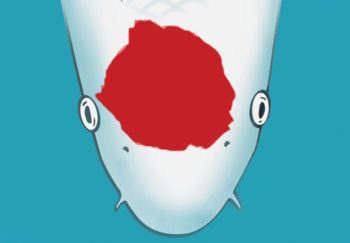>> Feature Article | Language of Koi: Understanding Kohaku Patterns

(1) The Tancho pattern refers to a single hi spot that is exclusive to the head. No other hi plates are present on these koi. The lone hi patch should be circular and symmetrical and sit on the center of the koi’s head. Ideally, it should not reach forward beyond the nostrils, touch the eyes or come in contact with the first row of scales on the koi’s back. Tancho is one of the most desired patterns, but it’s also one of the most elusive. Nontraditional versions of Tancho such as oval, diamond or heart-shaped are becoming popular with koi collectors.

The (3) Classic or Traditional U pattern describes the front edge of the hi pattern that lies centrally on the head and resembles a horseshoe, or U shape. This hi plate continues onto the body to form one large hi patch. Ideally, the Classic U pattern should not reach too far down the face of the koi. It should go no farther forward than the eyes. Ideally, the U-shaped pattern should not spread to touch the eyes or nostrils of the koi.
Another very popular head pattern is (4) Kuchibeni. This is a Japanese term that describes hi appearing on the koi’s mouth or lips. It literally means “lipstick” in the Japanese language. Many times a small blotch of hi on the tip of the nose can also be considered Kuchibeni. A Kuchibeni head pattern often helps to balance the hi pattern, especially if the head has little or no hi marking at all.
(5) Hanatsuki is a head pattern where the hi plate reaches all the way forward to the tip of the nose or mouth of the koi. A Hanatsuki-style head pattern can be very unusual, though it is not as popular as some of the other styles. A heavy hi pattern on the body will help to keep this substantial head pattern in balance.
A heavy-head pattern that spreads over the face or head is called (6) Menkaburi. It is sometimes called a hooded or red-cap pattern for obvious reasons. This type of head pattern can give the impression of too much hi, especially when the volume of head hi is not in balance with the rest of the hi pattern on the body. Balance of the overall pattern is preferred in this type.

